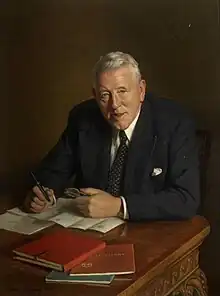The Lord Fleck | |
|---|---|
 Alexander Fleck painted in 1960 by E. I. Halliday | |
| Born | 11 November 1889 |
| Died | 6 August 1968 (aged 78) |
| Alma mater | University of Glasgow |
| Awards | KBE Fellow of the Royal Society (1955)[1] Wilhelm Exner Medal (1957) Castner Medal (1947) |
| Scientific career | |
| Institutions | Imperial Chemical Industries Royal Institution University of Glasgow |
Alexander Fleck, 1st Baron Fleck KBE FRS FRSE[1] (11 November 1889 – 6 August 1968) was a British industrial chemist.[2]
Background and education
Fleck was born on 11 November 1889, the son of Robert Fleck, coal-merchant of the firm Alexander Fleck & Co of 45 Hope Street,[3] and his wife, Agnes Hendry Duncan. He was educated in both Saltcoats and Hillhead High School in Glasgow.[4] He left school at the age of fourteen to become a laboratory boy at the University of Glasgow. When Frederick Soddy arrived as a lecturer, Fleck became his assistant.
He studied at evening classes, eventually becoming a student of Glasgow University and graduating BSc in 1911. He then became a post graduate researcher, gaining a doctorate (DSc) in 1916 in the chemistry of radioactive substances.[5] He was associated with the Beatson Oncology Centre where he studied the effects of radium on cancerous growths at the beginning of World War I.
Career
Fleck was appointed to the board of ICI in 1944 and was its chairman from 1953 to 1960. He was also chairman of Scottish Agricultural Industries, the Coal Board Organization Committee, the Scientific Advisory Council, and the Nuclear Safety Advisory Committee. He was elected an Honorary Fellow of the Royal Society in 1955.[1] He also received honorary doctorates from Glasgow University, Durham University, the University of Nottingham, Oxford University, University of London and Dublin University.[6]
In 1960 he was invited to deliver the MacMillan Memorial Lecture to the Institution of Engineers and Shipbuilders in Scotland. He chose the subject "Interdependence of Engineering and Chemistry".[7] He was President of the Royal Institution from 1963 to 1968. In 1961 he was elevated to the peerage as Baron Fleck, of Saltcoats in the County of Ayrshire.[8]
Personal life
In 1917 he married Isabel Mitchell Kelly (died 1955). They had no children.[9]
Lord Fleck died in London on 6 August 1968, aged 78, when the barony became extinct.
References
- 1 2 3 4 Holroyd, R. (1971). "Alexander Fleck. Baron Fleck of Saltcoats 1889-1968". Biographical Memoirs of Fellows of the Royal Society. 17: 242–254. doi:10.1098/rsbm.1971.0010.
- ↑ Portraits of Alexander Fleck, Baron Fleck at the National Portrait Gallery, London
- ↑ Glasgow Post Office directory 1889
- ↑ Biographical Index of Former Fellows of the Royal Society of Edinburgh 1783 – 2002 (PDF). The Royal Society of Edinburgh. July 2006. ISBN 0-902-198-84-X. Archived from the original (PDF) on 24 January 2013. Retrieved 9 May 2016.
- ↑ Reed Business Information (22 August 1957). "New Scientist". New Scientist Careers Guide: The Employer Contacts Book for Scientists. Reed Business Information: 20–. ISSN 0262-4079.
{{cite journal}}:|author=has generic name (help) - ↑ Biographical Index of Former Fellows of the Royal Society of Edinburgh 1783 – 2002 (PDF). The Royal Society of Edinburgh. July 2006. ISBN 0-902-198-84-X. Archived from the original (PDF) on 24 January 2013. Retrieved 9 May 2016.
- ↑ "Hugh Miller Macmillan". Macmillan Memorial Lectures. Institution of Engineers and Shipbuilders in Scotland. Archived from the original on 4 October 2018. Retrieved 29 January 2019.
- ↑ "No. 42272". The London Gazette. 7 February 1961. p. 933.
- ↑ Biographical Index of Former Fellows of the Royal Society of Edinburgh 1783 – 2002 (PDF). The Royal Society of Edinburgh. July 2006. ISBN 0-902-198-84-X. Archived from the original (PDF) on 24 January 2013. Retrieved 9 May 2016.